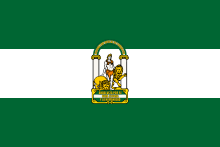Seville Fair
| Seville Fair/April Fair Feria de Sevilla/Feria de Abril | |
|---|---|
 Women in flamenco dresses at the April Fair. | |
| Dates | A week in the spring (two weeks after Easter) |
| Location(s) | Seville, Spain |
| Founded | 1846 |
| Attendance |
5,000,000 (week total) 850,000 (Friday night)[1] |
| Budget | €3,000,000[2] |
The Seville Fair (officially and in Spanish: Feria de abril de Sevilla, "Seville April Fair") is held in the Andalusian capital of Seville, Spain. The fair generally begins two weeks after the Semana Santa, or Easter Holy Week.
The fair officially begins at midnight on Monday, and runs six days, ending on the following Sunday. During past fairs, however, many activities have begun on the Saturday prior to the official opening. Each day the fiesta begins with the parade of carriages and riders, at midday, carrying Seville's leading citizens which make their way to the bullring, La Real Maestranza, where the bullfighters and breeders meet.
For the duration of the fair, the fairgrounds and a vast area on the far bank of the Guadalquivir River are totally covered in rows of casetas (individual decorated marquee tents which are temporarily built on the fairground). These casetas usually belong to prominent families of Seville, groups of friends, clubs, trade associations and political parties. From around nine at night until six or seven the following morning, at first in the streets and later only within each caseta, there are crowds partying and dancing sevillanas, drinking Sherry, manzanilla or rebujito, and eating tapas.[3] This fair also has an amusement park that comes with it and has lots of games to play along with roller coasters to ride.
History
The Fair dates back to 1847 when it was originally organized as a livestock fair by two councillors born in Northern Spain, Basque José María Ybarra and Catalonian Narciso Bonaplata. Queen Isabel II agreed to the proposal, and on 18 April 1847 the first fair was held at the Prado de San Sebastian, on the outskirts of the city.
It took only one year before an air of festivity began to transform the fair, due mainly to the emergence of the first three casetas, belonging to the Duke and Duchess of Montpensier, the Town Hall, and the Casino of Seville. During the 1920s, the fair reached its peak and became the spectacle that it is today.
Location
Since 1973, the Feria de Abril takes place at the real de la feria, an area of 24 blocks (450,000 m2) which is located between Los Remedios and Tablada. In 2012 there were 1048 casetas.[2] The streets of the Real are named after famous bullfighters such as Juan Belmonte and Pascual Márquez. Next to the Real is the Calle del Infierno (Hell Road), an amusement park which offers many recreational activities; a circus is usually set furthest from the Real on the back of the Parque de los Príncipes. Construction of the portada (the main gate) starts months in advance, and it takes several weeks to clear the place after the end of the Fair.

Plans to relocate the Fair to the Charco de la Pava have existed for the past 20 years, but the local government is yet to present any plans to transform the Real. For years the Charco de la Pava has been used as the main parking lot for Fair attendees.
Pescaíto

Monday night in the Feria de Abril is referred to as la noche del pescaíto (night of the fish) due to the fact that fish is the traditional dish to have for dinner. Celebrations officially start at midnight between Monday and Tuesday when the lights of the portada are turned on. This event is called the alumbrao. People gather in front of the portada to watch the alumbrao and then go to the casetas to have dinner and spend the whole night at the Real.
Costumes
La Feria de Abril is accompanied by men and women dressed up in their finery, ideally the traditional "traje corto" (short jacket, tight trousers and boots) for men and the "faralaes" or "trajes de flamenca" (flamenco-style dress) for women. The men traditionally wear hats (or sombreros) called "cordobés". Nowadays, standard suits have replaced trajes cortos as men's most common outfit.
Future fair dates
- 2 May° 7 May 2017
- 17 April - 22 April 2018
- 7 May - 12 May 2019[4]
Image gallery
| Wikimedia Commons has media related to Feria de Abril. |
 Amusement ride at the 2007 Seville Fair
Amusement ride at the 2007 Seville Fair Lanterns in the 2007 Seville Fair
Lanterns in the 2007 Seville Fair- Main entrance to the Seville Fair April, 2010
- Exterior of a caseta
 Inside a caseta
Inside a caseta
References
- ↑ "La afluencia a la Feria de Abril se estabiliza en cinco millones de visitas", El País, 1999.
- 1 2 "En la Feria de Abril no hay recortes y se disfrutará de la fiesta al completo", teinteresa.es, 2012.
- ↑ http://www.cyberspain.com/life/seville.htm Cyberspain
- ↑ "Calendario de Fiestas Sevilla", AndaluNet
External links
- Feria de Abril 2010
- The 2006 Feria de Abril (April Fair)
- Feria de Abril
- Andalucia.com
- Exploreseville "Feria de Abril"
- "Photos and Videos, Sevilla Fair 2007 and 2008. Feria de Abril de Sevilla"
- Photos Seville Fair 2008 "Feria de Abril"
- Seville Fair 2008 video in Youtube
Coordinates: 37°22′16″N 5°59′51″W / 37.37111°N 5.99750°W
